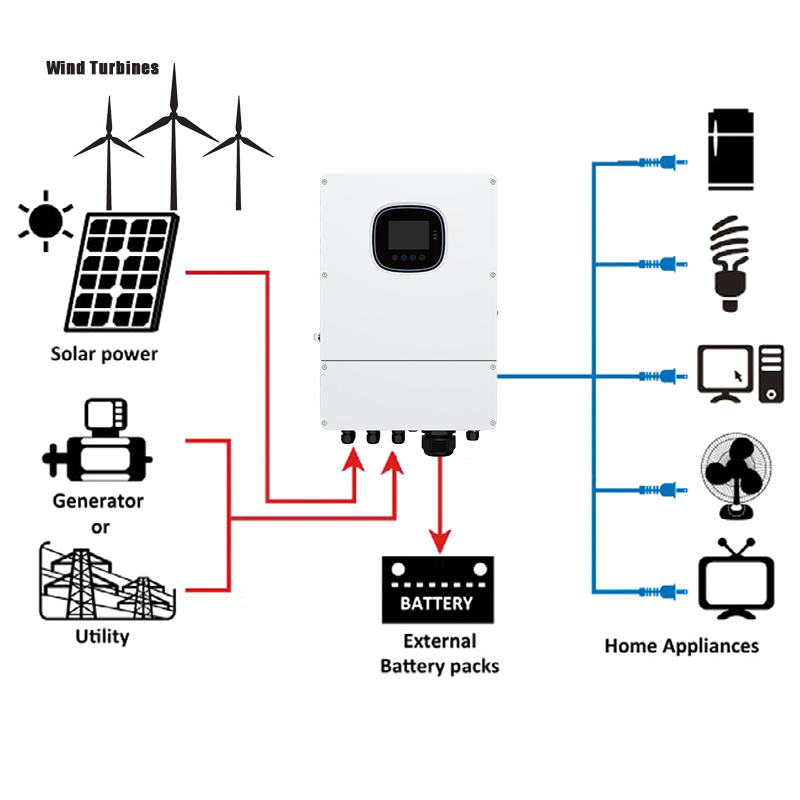Today, as energy is increasingly scarce, new energy is being used more and more widely. Being the cornerstone of new energy systems, the correlation between inverter power and load power holds immense significance. This piece delves deeply into this relationship, using inductive and resistive loads as case studies to offer a comprehensive analysis. By doing so, readers can gain a clearer grasp of inverter technology for practical application and understanding.
1. Inverter type: grid-connected inverter and off-grid inverter
Before discussing the power relationship, we need to distinguish between two main types of inverters: grid-connected inverter and off-grid inverter.
Grid-connected inverter: This inverter connects the generated AC power to the public grid. It needs to run synchronously with the grid and has a protection mechanism to prevent reverse power supply. The power output of the grid-connected inverter is usually limited by the grid and needs to meet the various technical specifications of the grid.
Off-grid inverter: This inverter is not connected to the public grid, but supplies power to independent loads, such as remote areas or independent power systems. The power output of the off-grid inverter mainly depends on its own design and load requirements. The limitation of its power output mainly comes from the rated power of the inverter itself.

2. Relationship between inverter power and load power: basic principle
The power output of the inverter must meet the power demand of the load. If the load power exceeds the rated power of the inverter, the inverter will be overloaded, which may cause damage or reduce efficiency. Ideally, the inverter output power should be slightly greater than the load power to provide a certain margin to cope with the fluctuation of load power. However, in practical applications, the type of load will significantly affect this relationship.
3. Differences between inductive loads and resistive loads
Loads can be roughly divided into two categories: resistive loads and inductive loads.
Resistive loads: The current and voltage of this type of load are in phase, such as resistance heaters, incandescent bulbs, etc. Their power calculation is relatively simple, and P = VI (power = voltage × current) can be used directly.
Inductive loads: The current of this type of load lags behind the voltage, such as motors, transformers, fluorescent lamps, etc. In addition to consuming active power, they also consume reactive power, resulting in actual power demand greater than the simple VI calculation result. This part of reactive power will generate losses in the power system and affect the power factor.
4. The impact of inductive load on inverter power
For inductive loads, the rated power of the inverter needs to take into account its active power and reactive power. Due to the current lag of the inductive load, the inverter needs to provide a larger current to meet the same power demand. This will not only affect the efficiency of the inverter, but may even cause overload, especially if the inverter is not designed with power factor correction (PFC) function. Therefore, when using inductive loads, it is crucial to choose an inverter with a larger power margin.
5. Example
Assume that the rated power of an off-grid inverter is 5KW.
If the load is a 5KW resistive load (such as a resistance heater), then the inverter can easily meet the demand.
If the load is a 5KW inductive load (such as a motor), the actual output power of the inverter may need to be higher than 5KW. Our safe configuration should be 2 to 3 times the load power to meet the actual power requirements of the motor and avoid the instantaneous startup power of the equipment being too high, which may cause the inverter to be unusable or reduce the service life of the inverter.
6. Conclusion
Choosing a suitable inverter requires careful consideration of the type and power requirements of the load. When dealing with inductive loads, opting for an inverter with a substantial power margin and incorporating power factor correction is crucial for safe and dependable operation. Whether it’s a grid-tied or off-grid inverter, assessing load characteristics accurately is pivotal for efficient renewable energy utilization. Understanding the interplay between inverter and load power is essential for selecting the right inverter in real-world scenarios and optimizing energy efficiency.

